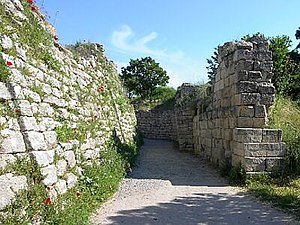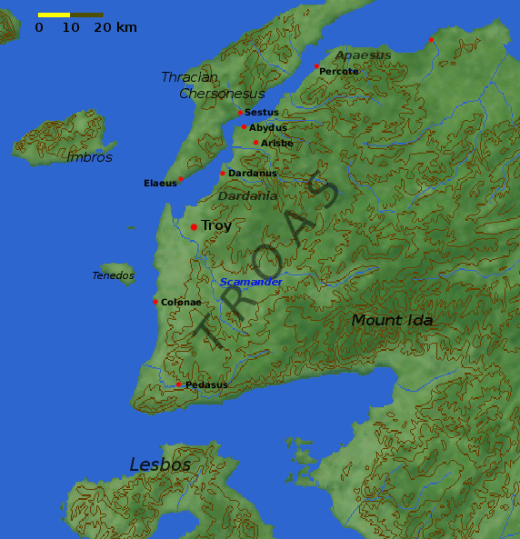|
Greek city of Abydos in Troas
Bronze 12mm (2.5 grams) Struck circa 320-200 B.C.
Reference: SNG Copenhagen 33-5 var.; SNG von Aulock 1445 var.
Laureate head of Apollo right.
ABY, Eagle standing right with closed wings.
Abydos was a Milesian colony on the shores of the Hellespont, opposite Sestos.
You are bidding on the exact item pictured, provided with a Certificate of Authenticity and Lifetime Guarantee of Authenticity.
 In Greek and Roman mythology, Apollo, is one of the most important and diverse of the Olympian deities. The ideal of the kouros (a beardless youth), Apollo has been variously recognized as a god of light and the sun; truth and prophecy; archery; medicine and healing; music, poetry, and the arts; and more. Apollo is the son of Zeus and Leto, and has a twin sister, the chaste huntress Artemis. Apollo is known in Greek-influenced Etruscan mythology as Apulu. Apollo was worshiped in both ancient Greek and Roman religion, as well as in the modern Greco-Roman Neopaganism. In Greek and Roman mythology, Apollo, is one of the most important and diverse of the Olympian deities. The ideal of the kouros (a beardless youth), Apollo has been variously recognized as a god of light and the sun; truth and prophecy; archery; medicine and healing; music, poetry, and the arts; and more. Apollo is the son of Zeus and Leto, and has a twin sister, the chaste huntress Artemis. Apollo is known in Greek-influenced Etruscan mythology as Apulu. Apollo was worshiped in both ancient Greek and Roman religion, as well as in the modern Greco-Roman Neopaganism.
As the patron of Delphi (Pythian Apollo), Apollo was an oracular god – the prophetic deity of the Delphic Oracle. Medicine and healing were associated with Apollo, whether through the god himself or mediated through his son Asclepius, yet Apollo was also seen as a god who could bring ill-health and deadly plague as well as one who had the ability to cure. Amongst the god’s custodial charges, Apollo became associated with dominion over colonists, and as the patron defender of herds and flocks. As the leader of the Muses (Apollon Musagetes) and director of their choir, Apollo functioned as the patron god of music and poetry. Hermes created the lyre for him, and the instrument became a common attribute of Apollo. Hymns sung to Apollo were called paeans.
In Hellenistic times, especially during the third century BCE, as Apollo Helios he became identified among Greeks with Helios, god of the sun, and his sister Artemis similarly equated with Selene, goddess of the moon. In Latin texts, on the other hand, Joseph Fontenrose declared himself unable to find any conflation of Apollo with Sol among the Augustan poets of the first century, not even in the conjurations of Aeneas and Latinus in Aeneid XII (161-215). Apollo and Helios/Sol remained separate beings in literary and mythological texts until the third century CE.
Abydos, an ancient city of Mysia, in Asia Minor, situated at Nara Burnu or Nagara Point on the best harbor on the Asiatic shore of the Hellespont. Across Abydos lies Sestus on the European side marking the shortest point in the Dardanelles, scarcely a mile broad. The strategic site has been a prohibited zone in the twentieth century. Hero and Leander’s story was been near Abydos.
Abydos was first mentioned in the catalogue of Trojan allies (Iliad ii.836). It probably was a Thracian town, as Strabo has it, but was afterwards colonized by Milesians, with the consent of Gyges, king of Lydia, around 700 BC. It was occupied by the Persians in 514 BC, and Darius burnt it in 512. Here Xerxes built two bridges of boats and crossed the strait in 480 BC when he invaded Greece.
Abydos thereafter became a member of the Delian League, until it revolted from Athenian rule in 411 BC. It allied itself to History of Sparta, until 394 BC; King Agesilaus of Sparta crossed here while returning to Greece. Abydos then passed under Achaemenid rule, until 334 BC. Alexander the Great threw a spear to Abydos while crossing the strait and claimed Asia as his own.
Abydos is celebrated for the vigorous resistance it made against Philip V of Macedon in 200 BC, and is famed in myth as the home of Leander. It minted coins from the early fifth century BC to the mid-third century AD.
The town remained until late Byzantine times an important toll and customs station of the Hellespont, its importance thereafter being transferred to the Dardanelles, after the building of the “Old Castles” by Sultan Mehmet II (c. 1456).
 Abydos and the Hellespont Abydos and the Hellespont
The Troad or Troas is the historical name of the Biga peninsula (modern Turkish: Biga Yarımadası, Greek: Τρωάς) in the northwestern part of Anatolia, Turkey. This region now is part of the Çanakkale province of Turkey. Bounded by the Dardanelles to the northwest, by the Aegean Sea to the west and separated from the rest of Anatolia by the massif that forms Mount Ida, the Troad is drained by two main rivers, the Scamander (Karamenderes) and the Simois, which join at the area containing the ruins of Troy. Grenikos, Kebren, Simoeis, Rhesos, Rhodios, Heptaporos and Aisepos were seven rivers of the Troad and the names of the river gods that inhabited each river.

Part of the walls of Troy
History
The Troad gets its name from the Hittites’ name for the region, Taruisa. This identification was first put forth by Emil Forrer, but largely disputed by most Hittite experts until 1983 when Houwink ten Cate showed that two fragments were from the same original cuneiform tablet and in his discussion of the restored letter showed that Taruisa and Wilusa (Troy) were correctly placed in northwestern Anatolia. According to Trevor Bryce, Hittite texts indicate a number of Ahhiyawan raids on Wilusa during the 13th century BC, which may have resulted with the overthrow of king Walmu.
Bryce also reports that archeological surveys conducted by John Bintliff in the 1970s show that a powerful kingdom that held sway over northwestern Anatolia was based at Wilusa (Troy).
The kings of Pergamum (now Bergama) later ceded the territory of the Troad to the Roman Republic. Under the Empire, the territory of the Troad became part of the province of Asia; under the later Byzantine Empire, it was included in the thema of the Aegean Islands. Following its conquest by the Ottoman Empire, the Troad formed part of the sanjak of Biga.
In the New Testament
Paul visited Troas. He also refers to Troas when he asks his fellow worker Timothy out of Ephesus, to get his coat there.[3] This was a journey of about 500 kilometres (310 mi). Paul was accompanied by Luke.

|





 In Greek and Roman mythology, Apollo, is one of the most important and diverse of the Olympian deities. The ideal of the kouros (a beardless youth), Apollo has been variously recognized as a god of light and the sun; truth and prophecy; archery; medicine and healing; music, poetry, and the arts; and more. Apollo is the son of Zeus and Leto, and has a twin sister, the chaste huntress Artemis. Apollo is known in Greek-influenced Etruscan mythology as Apulu. Apollo was worshiped in both ancient Greek and Roman religion, as well as in the modern Greco-Roman Neopaganism.
In Greek and Roman mythology, Apollo, is one of the most important and diverse of the Olympian deities. The ideal of the kouros (a beardless youth), Apollo has been variously recognized as a god of light and the sun; truth and prophecy; archery; medicine and healing; music, poetry, and the arts; and more. Apollo is the son of Zeus and Leto, and has a twin sister, the chaste huntress Artemis. Apollo is known in Greek-influenced Etruscan mythology as Apulu. Apollo was worshiped in both ancient Greek and Roman religion, as well as in the modern Greco-Roman Neopaganism. Abydos and the Hellespont
Abydos and the Hellespont 






